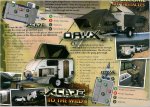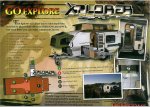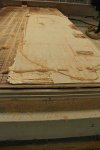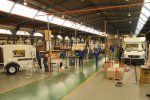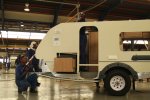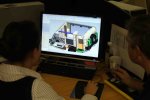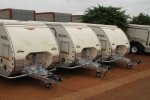Some updates and layouts
Hello all,
Just thought I'd give some updates and post some layouts that we have not done before. The Xplorer model has a privy room with an external shower that pops out from an enclosed recess, as well as a basin and vanity that also pops out from behind a closed panel. All the Safari range comes equipped with a fridge/freezer (80L National Luna in the Xplorer, and 40L Engel in the Xcape) and battery/inverter system, and fully stocked deployable kitchen. The kitchen on the Xplorer can be used inside our out.
In addition, here are some of the major differences between an off-road camper and a regular ol' Jayco, Outback, etc.
Chassis:
The Safari chassis is much more heavy duty (about 50% bigger) in comparison to the road going chassis as it is designed to take the punch of sustained off-road use.
The axle is much more heavy duty for the same reasons. The internal rubbers are bigger for the extra suspension & heat distribution. The swing arms are bigger & thicker to take the knocks. The stub shaft of the axle is bigger to take the knocks.
The wheels are 15” & not 14” with off road tires.
Walls:
The walls have a additional layer of ply on the aluminum side making the sandwich panel much stronger.
Walls & floor are bolted with internal & external brackets (as well as bonding materials) to ensure it can take the knocks and the constant flexing off road.
Body:
The Safari is narrower (about the same as the average 4x4 vehicle) than the average camper, so that the trailers wheels & body follow the same track as the tow vehicle. This means you can be sure that if you vehicle gets through the trail, the camper will as well.
The Safari is compact with many things that clip on or fold out as if designed to be functional in a small space whereas most travel trailers are a luxury van with everything permanently positioned.
The furniture uses a number of bolted fittings to ensure that they stay together in the harshest of environments. This is instead of being glued together.
Systems:
The Jurgens Safari is 100% 12V & gas with a battery system. All the lights, fridge, pump etc run on 12V. 110V can be plugged in to run the plug sockets & charge the battery system when near a mains source.
The hot water geyser is 110V & gas & can therefore be used if you are not plugged into mains power.
The Safari can charge the battery while driving while many campers can not. This is because the Safari is designed to do trails where you are traveling most of the time where as travel trailers tend to camp in the same place for a long time.
Testing:
The Jurgens Safari was tested at a military test ground. This is the SA Defence Force military test grounds. These day it is a private company that we pay to test our prototypes etc.
They have suspension tracks with a number of different surfaces, a banked oval track for high speed tests, tilt bridge for left & right roll over testing, various 4x4 tracks to test every typical 4x4 situation etc. The Safari has been extensively tested at this facility as well as all over Africa & Australia. It is built to take the knocks and the punches.
Basically, if your 4x4 tow vehicle (not a rock crawler or heavy wheeling!) can get through somewhere, so can the Safari, and when camped, you will have all the necessities to eat, sleep, shower in comfort.
Hello all,
Just thought I'd give some updates and post some layouts that we have not done before. The Xplorer model has a privy room with an external shower that pops out from an enclosed recess, as well as a basin and vanity that also pops out from behind a closed panel. All the Safari range comes equipped with a fridge/freezer (80L National Luna in the Xplorer, and 40L Engel in the Xcape) and battery/inverter system, and fully stocked deployable kitchen. The kitchen on the Xplorer can be used inside our out.
In addition, here are some of the major differences between an off-road camper and a regular ol' Jayco, Outback, etc.
Chassis:
The Safari chassis is much more heavy duty (about 50% bigger) in comparison to the road going chassis as it is designed to take the punch of sustained off-road use.
The axle is much more heavy duty for the same reasons. The internal rubbers are bigger for the extra suspension & heat distribution. The swing arms are bigger & thicker to take the knocks. The stub shaft of the axle is bigger to take the knocks.
The wheels are 15” & not 14” with off road tires.
Walls:
The walls have a additional layer of ply on the aluminum side making the sandwich panel much stronger.
Walls & floor are bolted with internal & external brackets (as well as bonding materials) to ensure it can take the knocks and the constant flexing off road.
Body:
The Safari is narrower (about the same as the average 4x4 vehicle) than the average camper, so that the trailers wheels & body follow the same track as the tow vehicle. This means you can be sure that if you vehicle gets through the trail, the camper will as well.
The Safari is compact with many things that clip on or fold out as if designed to be functional in a small space whereas most travel trailers are a luxury van with everything permanently positioned.
The furniture uses a number of bolted fittings to ensure that they stay together in the harshest of environments. This is instead of being glued together.
Systems:
The Jurgens Safari is 100% 12V & gas with a battery system. All the lights, fridge, pump etc run on 12V. 110V can be plugged in to run the plug sockets & charge the battery system when near a mains source.
The hot water geyser is 110V & gas & can therefore be used if you are not plugged into mains power.
The Safari can charge the battery while driving while many campers can not. This is because the Safari is designed to do trails where you are traveling most of the time where as travel trailers tend to camp in the same place for a long time.
Testing:
The Jurgens Safari was tested at a military test ground. This is the SA Defence Force military test grounds. These day it is a private company that we pay to test our prototypes etc.
They have suspension tracks with a number of different surfaces, a banked oval track for high speed tests, tilt bridge for left & right roll over testing, various 4x4 tracks to test every typical 4x4 situation etc. The Safari has been extensively tested at this facility as well as all over Africa & Australia. It is built to take the knocks and the punches.
Basically, if your 4x4 tow vehicle (not a rock crawler or heavy wheeling!) can get through somewhere, so can the Safari, and when camped, you will have all the necessities to eat, sleep, shower in comfort.

